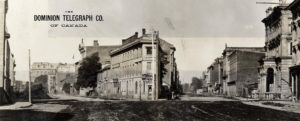 Head office of the Dominion Telegraph Company of Canada – Toronto, 1873: “Our (Toronto Head Office) ..is situated on the corners of Church, Wellington, and Front Streets. In the basement we find Mr. Munsie managing the store department. On the first floor is the receiving room under the direct management of Mr. L. M. McFarlaine. On the second floor are the offices of the General Manager, Secretary and Superintendent… We pass on to the third floor and here we find the operating-room under the management of Mr. S. E. Gibbs… We have a staff of sixteen operators”. Note: Above the telegraph sign at the top of the third floor window appears to be a cross-arm holding wires going directly into the operating room.
Head office of the Dominion Telegraph Company of Canada – Toronto, 1873: “Our (Toronto Head Office) ..is situated on the corners of Church, Wellington, and Front Streets. In the basement we find Mr. Munsie managing the store department. On the first floor is the receiving room under the direct management of Mr. L. M. McFarlaine. On the second floor are the offices of the General Manager, Secretary and Superintendent… We pass on to the third floor and here we find the operating-room under the management of Mr. S. E. Gibbs… We have a staff of sixteen operators”. Note: Above the telegraph sign at the top of the third floor window appears to be a cross-arm holding wires going directly into the operating room.
Origins
The Dominion Telegraph Company was originally chartered in June, 1868. “This company is intended to compete with the old established Montreal Telegraph Company (Which, by the way, is one of the best managed companies on the continent), and the result has already been a very material reduction of its tariff in advance of the threatened competition.” In October of 1869 it was reported that “the (Dominion Telegraph) Company have their poles up from Hamilton to Clifton (now known as Niagara Falls, ON) (the point of connection with the Atlantic and Pacific Company), and expect to open offices at Clifton, St. Catharine’s, Hamilton and Toronto in a few weeks.”
As noted, the Dominion Telegraph connected to the United States via the Atlantic and Pacific Telegraph Company. This allowed the DTCo access to all areas served by the A & P including their vast network of offices across the USA.
“The Dominion Telegraph Co. opened its lines from Suspension Bridge to Toronto, Canada, for business, on Thursday, February 4th, 1869. The Atlantic and Pacific Telegraph Company connect with the Dominion Company at Suspension Bridge.” “Offices are open in Toronto, Hamilton and St. Catharines. The instruments used on this line are from CHESTER, of New York, and are the finest I ever saw. The line itself is built in exactly the same style as the Atlantic and Pacific… There has also been a great reduction of rates made by the Montreal Company. A message can now be sent over nearly the whole of Ontario for 25 cents, and the extra words are only one cent each. The telegraphing public have to thank the Dominion Company for this, as the only reductions the Montreal Company have made were occasioned by the starting of the opposition companies.”
There were allegations of improper spending in May of 1869 “Great dissatisfaction has hitherto existed among the shareholders on account of the contract with Mr. S. Reeve, under which it was claimed that he was paid twice as much per mile for construction and equipment of the line as the work was worth. The directors… took the happy method of “dispensing with his services” by “stopping the supplies” thus obliging that gentleman to surrender his contract” From “The Telegrapher” Sept 25th, 1869. The issue of questionable spending was first reported in the Montreal Trade Review and it was thought that the story was planted by the MTCo as a way to tarnish the image of their rival. It was described in the Telegrapher as “a violent attack (against the Dominion Telegraph Company) by The Montreal Company or its’ employees … and it has seriously hurt the sale of stock in the Dominion Company”
Progress of the company was summarized at the annual company meeting held at Toronto Jan 11th, 1870: “The line to Whitby and Oshawa was placed under contract and completed… The extension of the line to Montreal and Ottawa (is) considered to be of primary importance; next in order the extension westward to London, Windsor and Sarnia, with a loop through Galt, Guelph and their surroundings; then from Toronto to Barrie, Port Hope and Peterboro… Mr. Colby, the contractor, who had built the extension to Oshawa, had no hesitation in saying that he could undertake to have the line in good working order from Oshawa to Ottawa via Prescott by July of 1870”
A short paragraph in the Kingston British Whig on June 1, 1870 indicates on which streets the company built their lines in the city of Kingston. “Of the Dominion Telegraph Company, praying for permission to place their poles along Johnson and Wellington Streets, to carry their line through the city. – Granted under supervision of the City Engineer.” The poles likely came into the city on the Kingston road, now known as Highway 2 which becomes Princess Street in the city, then turned south on Wellington and east on Johnson Street which leads directly to the DTCo office at 167 Ontario Street at the southeast corner of Johnson and Ontario Streets. By September 9th, 1870 the Newmarket Era reported that “The Dominion Telegraph line is now open to Kingston. it will be completed to Ottawa next week, where it will be connected with the People’s line, and thus be ready to send messages to Montreal and Quebec.” The People’s Telegraph was a small independent company that served areas in the province of Quebec.
In January of 1871 it was reported that “during the past year the lines have been extended from Oshawa eastward to Montreal, and (intersecting the main line) from Prescott to Ottawa; and from Hamilton to London..a second wire from Hamilton to Montreal, and from Prescott to Ottawa has proved a great advantage”
By January of 1871 the company had run a “second wire from Montreal to Hamilton, and from Prescott to Ottawa.” The company now had a “total of 629 miles of pole line and 1116 miles of wire in operation.” “By the close of 1871 they had purchased the People’s Telegraph Company thus extending their operations to the sister Province of Quebec.”
The company had been reorganized late in 1869 and was officially reincorporated by an act of Parliament in April of 1871. The articles of incorporation specifically say the company “may lay down, erect and maintain its line or lines of Telegraph along the sides of and across any public highways, bridges, water-courses or other such places”. It goes on to say they specifically may not “erect posts or place their lines of Telegraph upon the line of any Railway without the consent of the Company to which such Railway belongs”. Note that the Montreal Telegraph Company already held rights to build along most railways at this time.
Progress of the company for the years 1869 to 1873 was summarized in an article in “The Telegrapher” Feb 21, 1874.
| Year | Milles of Pole Line | Miles of Wire | Offices |
| 1869 | 147 | 147 | 6 |
| 1870 | 629 | 1116 | 35 |
| 1871 | 1510 | 2933 | 106 |
| 1872 | 2177.5 | 3942 | 166 |
| 1873 | 2585 | 4574 | 251 |
At the DTCo general meeting in February of 1872 it was announced that “Contracts have already been entered into for the extension of the company’s lines, as soon as the season will permit, northward from the City of Toronto, and passing through the principal towns and villages on the route by the town of Collingwood, and from Port Hope via Peterboro’, Lindsay, Beaverton and Orillia to Barrie.” Two items in the Bowmanville Merchant in June and July 1872 mention progress of this pole line. In the June 28th issue there is mention of a Mr. Watson who has the contract to build the line from Peterborough to Barrie and then on July 19th, 1872 there is an announcement that “The Dominion Telegraph Company has opened offices at Lindsay and Peterborough”. There is also a listing for an Omemee office by 1877, so it’s likely this line was built along the Lindsay highway (Highway 7).
Toronto, Canada, Feb. 14th 1873 “We have 10 wires running out of Toronto and it is the intention of this company to build several new lines this summer, besides stringing several new wires on the old poles; and, before the end of 1873, I can safely say there will be fifteen wires running out of Toronto. Let us look at last year’s work. A line was built from Oswego to Prescott, thereby giving Toronto a direct circuit to Oswego. A line was built from Toronto to Goderich, another from London to Sarnia, another from Toronto to Port Hope, by way of Barrie and Peterboro, and another from Brockville to Pembroke. The coming season we will meet the monopolists on their own ground, face to face, when it will be proved that an opposition can live in Canada, and the people will support it.” From the Telegrapher, March 1st, 1873
By the close of 1873 they had added lines “From Sarnia to Kent Bridge, intersecting the London and Chatham lines, over 59 miles; from Collingwood to Owen Sound, 39 miles; from Trenton to Picton, 32 miles; from Whitby, through Port Perry, to Little Britain, 36 miles; from Clinton, on the Goderich line, to Kincardine, 56 miles; from Brantford to the town of Simcoe and Port Dover, 33 miles; from Mount Forest through Durham and Walkerton, to Kincardine, 50 miles; from Mount Forest to Harriston, 10 miles; and a short connection between Ottawa and Aylmer.” The Port Perry office opened in September, 1873 in the Royal Arcade building under the care of W.H. McCaw. who is listed as a jeweler and dealer in books & stationery.
Meeting minutes from February, 1875 describe further expansions of the company’s network: “The Lines built during the past year (1874) consist of: From Peterboro’ to Prescott; Lindsay to Bobcaygeon; Aylmer to Portage dur Fort; Seaforth to Listowell; Listowell to Harriston; St. Thomas and Tilsonburg to Port Burwell; Hamilton to Port Dover; Harriston to Wingham; Toronto to Whitby; Toronto to Weston, and St. Catharines to Niagara and also extra wires from Prescott to Ottawa and Montreal, not only greatly increase our capacity, but also give us an entire new route to these important points, in all exceeding 517 miles of pole line and 1,239 miles of wire. These additions bring up the total pole mileage to 3102 miles, with 5807 miles of wire and 305 offices.” (From Dominion Telegraph Co. Annual Meeting 10th Feb, 1875 at the head offices in Toronto.)
Final Years and Takeover by GNW
By the end of 1878 the Dominion Telegraph and Montreal Telegraph Companies had “agreed upon a basis for ‘pooling’ their gross receipts, and dividing the net profits…Montreal company is to receive seventy per cent and the Dominion thirty per cent…” as a consequence, “a number of country offices will be closed, but few employees of the companies will be thrown out of employment. The Dominion Company has completed its connection with the Lower Provinces. The tariff between the maritime provinces and Ontario and Quebec will in future be thirty cents for ten words, instead of fifty”
An ongoing economic depression and gradual rate reductions had weakened both the DTCo and th MTCo – the pooling arrangement was intended to keep rates stable and reduce the duplication of services. But, by January 1st, 1879: “The proposed pooling arrangement between the Montreal and Dominion Telegraph companies had fallen through” Dominion Telegraph general meeting was held at Toronto Feb 12, 1879. At the end of 1878 the company had a pole mileage of 4618 miles and wire mileage of 8882 with 492 offices…The President..noted that the continued depression in all branches of industry had the effect of reducing the telegraphic business as well as other business generally and as a result the gross returns of the Company showed a decrease.”
Failure of the pooling agreement led the company to look at other options to keep the business financially viable. “The Dominion Telegraph Company have just succeeded in getting an amendment to is charter passed through our Houses of Parliament. It empowers the company to lease its line to any other company.” Shortly afterward it was announced that the American Union Telegraph Company had “secured a lease of the entire Dominion Telegraph Company of Canada” … “This had a depressing effect on the price of Montreal Telegraph stock while the price of the Dominion stock increased to a marked degree… The lease was ratified at a meeting on July 2nd by Dominion Telegraph shareholders”
Later in July, 1879 it was announced that the American Union Co. “now owned 1/3 capital stock in DTCo. as well as a 99 year lease on their lines.. pooling negotiations some time ago fell through because the Montreal Company thought it could force the DTCo to accept about any terms it chose to offer. Now that the Dominion has concluded a lease with the American Union Company, the Montreal feels very sick, and offered to reopen negotiations, promising even better terms than those offered by the American Union Co. The offer was rejected.” From “The Operator” July 15th 1879
“It seems the rivalry between the two Canadian telegraph companies..is as bitter as ever. Some time ago an effort was made to effect an amicable arrangement, by which the companies should “pool” their receipts, after the fashion of the WU and A&P (in the US). Negotiations were broken off, however owing as was alleged to an exhibition of bad faith on the part of the Montreal Company. Since then, even after the leasing of the Dominion lines to the American Union, the two companies have been even less friendly than before. It seems that an understanding had been arrived at some time ago that neither company should reduce the rate for 10 words through Canada below 25 cents. The Dominion people claim, however, that the Montreal company has violated the agreement in several instances, and has endeavored to supplant the Dominion company in reference to press matter. The Dominion Company, therefore, on Monday September 6th, issued posters and advertisements announcing a general reduction to twenty cents for ten words or less on any part of the company’s lines. This reduction caused considerable excitement in Canada, and was immediately followed by similar reduction on the part of the Montreal company.”
“An important decision” A telegram from Toronto, Ont., says that the suit of the A& P Telegraph Co. against the Dominion Telegraph Company was decided, September 15th in favor of the Dominion Company on a demurer to the bill of the A & P and judgment given in favor of the Dominion Company with costs. The details of the case are familiar to the Operator readers. When, in 1877, the A & P and Western Union merged, the A & P offices all over the country were closed, thereby cutting off a large amount of US traffic for Canada from the DTCo’s lines, and when the American Union was started a year ago, the DTCo, as a matter of self-protection, it claims, was compelled to make an arrangement with it for US business. This arrangement finally culminated in the lease of the entire lines of the Dominion Company to the American Union. Since that arrangement was made, the A & P company has been endeavoring by all means in it’s power to prevent the DTCo from exchanging any business with the American Union, and finally instituted the suit referred to above which it has now lost.”
At the same time as the price war and general economic depression, various moves in the American telegraph industry laid the groundwork for the eventual takeover of both the Dominion and Montreal Telegraph Companies. The American railroad baron Jay Gould had acquired the Atlantic and Pacific Telegraph company in 1875. Two years later, in 1877 he sold the company to Western Union who then closed the A&P offices effectively cutting off the Dominion Telegraph’s connections to most cities in the US. The DTCo was then forced to seek out an alternative American company to connect with and eventually signed an agreement with another company owned by Jay Gould, The American Union Telegraph Company. In June of 1879 the DTCo entered a 99 year lease agreement with The American Union. Then, in July of 1881 Gould sold the American Union to the Western Union transferring the DTCo lease with the sale. Control of the Dominion Telegraph was then transferred to a Western Union subsidiary – The Great North Western Telegraph Company. The Great Northwestern Telegraph Company had been purchased by The Western Union Telegraph Company in 1881 but was run as a separate entity. The Montreal Telegraph Company soon realized they could not compete with the GNW/DTCo/WU alliance especially in their financially weakened state and by August of 1881 had ratified an agreement to lease their lines to the GNW for a period of 99 years as well. This consolidated virtually all telegraph business in Canada under the Great Northwestern Telegraph Company with Western Union as a majority shareholder. GNW quickly reinstated the former tariff of 25 cents per 10 words .
- Toronto 1870’s – Looking north on Church St. from Front at Wellington. DTCo pole line on east (right) side.
- Toronto, 1876 – Church Street looking north from Lombard. Globe topped pole line on east side of Church St.
- Toronto, 1873 – Ontario Chambers building NE corner of Church at Front Sts. Globe topped pole with 22 Ramshorn insulators on east side of Church Street.
- Toronto 1874 – St James Cathedral. East side of Church at King showing globe topped pole line.
- Toronto 1874 – View looking south on Church St showing St. James Anglican church globe-topped pole of the DTCo line with 22 Ramshorns
- Toronto, Ontario – 1874. View of Adelaide Street looking east from Victoria Street toward Church. Globe-topped poles can be seen on the right running from Church to Toronto Street.
- Toronto 1875 – Yonge St. looking south from King. Globe topped poles of the DTCo visible on both sides of the street. Note DTCo sign on the left attached to pole.
- Toronto 1875 – MTCo sign on the left building on the corner. Poles from both companies are visible
- Toronto 1870’s – View looking north on Toronto St toward Adelaide. Both DTCo and MTCo had offices on the west (left) side of this street.
- Toronto, 1876 – Looking toward southwest corner of Toronto and Adelaide Sts. MTCo signs visible on the corner of the building just below 2nd floor. MTCo and DTCo poles visible.
- 1872 Excerpt from “Commercial Houses of Toronto” showing Dominion Telegraph building and advertisement.
- Toronto 1872 – Looking west at Front, Wellington and Church Sts. Dominion Telegraph offices at center.
Pole Lines and Offices
Photographs of Toronto from the 1870’s show pole lines that are very likely associated with the Dominion Telegraph Company. The poles are easily identified due to their use of mainly ramshorn or Ponds type insulators and a peculiar globe-shaped decoration carved into the top of each pole. Specifically, a pole line on the east side of Church Street leads directly to the head office of the company at the corner of Front, Wellington and Church Streets. An earlier view of Church street from 1868 shows no such pole line. Also of note is the only known photograph of a Dominion Telegraph Co. sign which is actually attached to ball-topped pole at one of their branch offices on Yonge Street in close proximity to the Great Western Railway ticket office.
Ball top poles seem to have been used for most of their lines, perhaps to differentiate from the poles of other telegraph companies. The busy main pole line on Church St. had 22 Ramshorn insulators on each pole and leads directly to the company’s head office in the Coffin Block building at the corner of Church, Front and Wellington Streets. The building was demolished in the 1890’s and is now the site of the famous Gooderham flatiron building.
- Pole with 22 Ramshorn insulators in front of the Ontario Chambers building at the northeast corner of Church and Front, 1873
- Dominion Telegraph globe-topped pole on Yonge Street, Toronto with what looks like 2 Ponds patent insulators.
- Dominion Telegraph sign at the Great Western Railway station. Yonge St., Toronto 1874.
- Kingston, ON – Hanley ‘Inner’ Station of the GTR at 167 Ontario St. about 1880. Sign beside pole advertising both The Dominion and Montreal Telegraph
We know from the articles of incorporation that the DTCo was empowered to “lay down, erect and maintain its line or lines of Telegraph along the sides of and across any public highways, bridges, water-courses or other such places.” An advertisement for tenders also confirmed their lines were built along roadways as opposed to railways. It was “for the construction of a single wire line, with brackets and insulators attached, and ready for a second wire from Toronto, eastward to Ottawa and Montreal, and westward form Dundas to Sarnia, along the main traveled roads.”
Insulators of the Dominion Telegraph Company
Dominion Telegraph embossed insulators are extremely rare – only a handful have ever been found. The insulator is a threadless CD 742 base embossed D. T. Co. At least two of the known 742s have been found in the Hamilton area. They could have been manufactured by either Burlington or Hamilton Glass Co. It’s also possible the embossed examples are rare because they were only used on the earliest parts of the DTCo lines from Niagara Falls to Hamilton constructed in 1868-1870 before the reorganization of 1871. From “The Telegrapher” Feb 29, 1868: “The line will be built in the same manner as the Atlantic and Pacific.. The company has appointed Mr. A. A. COLBY as Superintendent and Engineer of Construction. Mr. COLBY has had some eight years’ experience in the telegraph business… Mr. COLBY.. put up the Atlantic and Pacific line, last summer… His headquarters will be at Hamilton.”
It’s possible embossed DTCo insulators are rare because the Montreal Telegraph Company would not have approved of their insulator suppliers producing insulators for the competition and since they were a larger company they may have threatened to take their business elsewhere if they continued producing DTCo insulators.
Toronto pole lines show very few, if any glass pin type insulators and could possibly be representative of the company’s lines in general. All of the ball-topped poles show insulators that are either a ramshorn style installed under the crossarm or a ponds style installed on pins above the crossarms. The ramshorn style looks to be a metal encased glass sleeve with a hook, possibly a Brooks patent. The use of Ponds and Ramshorns styles could be due to the fact that the Dominion Telegraph “built their lines in the same manner as the Atlantic and Pacific Telegraph company” of the United States.
An article from The Telegrapher, Feb 8, 1873 states in error that CD 123.2 Chesters were used on some Dominion Telegraph lines. The “new line from Brockville to Pembroke and a wire from Ogdensburg to Oswego are on Chester’s Patent insulators”. This was soon corrected in the April 5 1873 issue of the Telegrapher. Correction: The line from Brockville to Pembroke “is on plain glass insulators” and “The Ogdensburg line has one wire on plain glass but the other is on Brooks’ improved insulators. All the wires of the Dominion Company in this city (Toronto) are brought to the main office on Brooks insulators. The poles are very handsome ones, fully equal to the Chicago lines before the fire. They were from twenty-five to thirty inches at the butt before dressing.” This verifies the company’s fairly wide spread use of the Brooks Improved (Ramshorn) insulator.
- Chesters Patent Insulator incorrectly attributed to lines of the DTCo.
- Brooks Patent Insulator. The style used by the DTCo is on the right.
- Kenosha “Cap Insulator” also known as the Pond’s Patent. They were used extensively by the DTCo.
The CD 742.3 threadless could possibly be the “plain glass insulator” mentioned in that article. The 742.3 without embossing seems to show up in older dumps throughout Ontario from time to time and it was common for threadless to be used in Canada as late as 1878 based on finds along railways built up to that time. A photograph of St. Thomas, Ontario from 1875 shows what appears to be a 742.3 and a Ponds Patent insulator on the same pole. It’s possible this was a DTCo pole as St. Thomas had a Dominion Telegraph Office at that time.
- St. Thomas, Ontario 1875 – Pole at right appears to have two 742.3 threadless and a Ponds Patent on the left side lower down on a side pin.
An article in the Jan 22nd, 1876 issue of the Telegrapher mentions the use of ‘Carbon’ insulators. “Mr. McQuarrie (Supt. of Construction) has just completed a line from Pictou to Tor Bay, Nova Scotia, for the Dominion Company to connect with the Direct Cable. It is built with large poles, Carbon insulators, and No. 9 iron wire.” There is another mention in the November 15th, 1873 issue of the Telegrapher: “the Kenosha Carbon insulator .. is being quite extensively used in Canada.” The Kenosha Insulator Company made two types of insulators – The Ponds Patent and the Kenosha Hook – their advertising does not distinguish between them, so the Carbon insulator mentioned could be either one. Photographs of DTCo poles in Barrie, Toronto and St. Thomas, Ontario verify the use of the Pond’s patent insulator though.
It’s unclear why a CD 143 DTCo embossed insulator has never been found – specifically with the fully spelled out company name – as both the Montreal Telegraph Co. and the Great North Western Telegraph Co. had CD 143’s with fully spelled out company names on them in the 1875 to early 1880’s time frame. It seems likely that unembossed threaded and threadless pintypes were usedby the company. After all, the DTCo had 14,000 miles of wire in January of 1880, so they would have had a minimum of 500,000 insulators in service depending on the pole spacing they used on their lines..
- 1872 Map of Toronto detail showing location of Dominion Telegraph offices and Montreal Telegraph Offices.
- Detail from 1858 map of Toronto showing DTCo predecessor “International Telegraph Office” at the intersection of Front and Wellington.
- Detail from 1858 Toronto Map showing Yonge to Church and Adelaide to Front Streets.
- Detail from 1880 Fire Insurance map showing Dominion Telegraph offices at the top right (Front, Wellington and Church)
- 1880 Fire Insurance Map detail – Toronto – DTCo had a sub office in the Masonic Hall on Toronto St. MTCo had an office at the corner of Adelaide and Toronto St.
- 1874 Toronto City Directory showing telegraph companies and their locations
- Toronto City Directory 1882 – Announcement that both the DTCo and MTCo have merged under the GNW charter.
Links:
References:
The Telegrapher: A Journal of Electrical Progress 1868-1881 from Google Books and Archive.org
The Operator: A Journal of Scientific & Practical Telegraphy from Google Books and Archive.org
Historic Toronto Photographs and City Directories from the Toronto Public Library Digital Archive
Historic St. Thomas, Ontario Photographs from the Elgin County Archives
Historic Toronto Maps from:
Goad’s Atlas of the City of Toronto http://goadstoronto.blogspot.ca/
Historical Maps of Toronto Website http://oldtorontomaps.blogspot.ca/p/index-of-maps.html
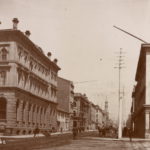
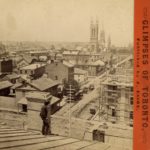
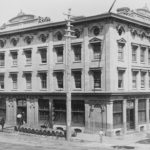
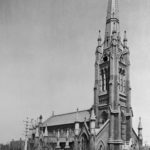
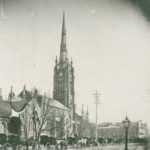
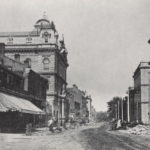
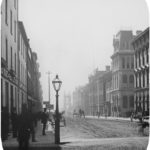
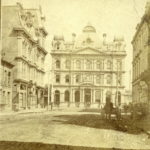
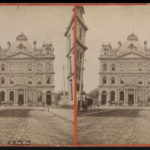
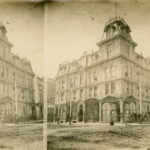
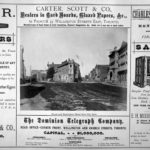
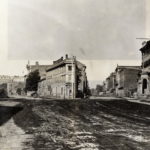
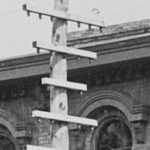
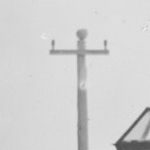
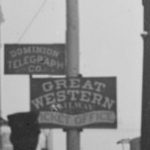
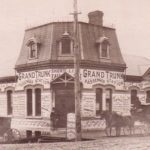
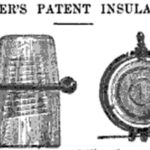
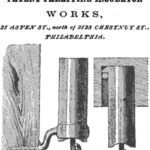
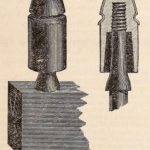
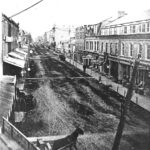
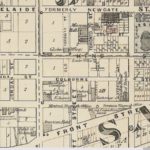
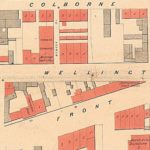
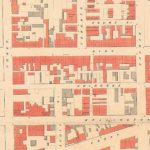
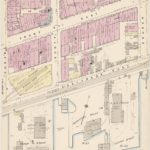
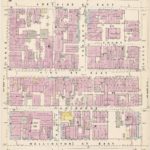
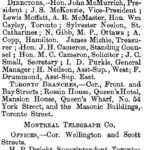
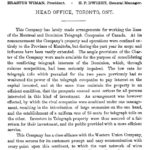
No Responses